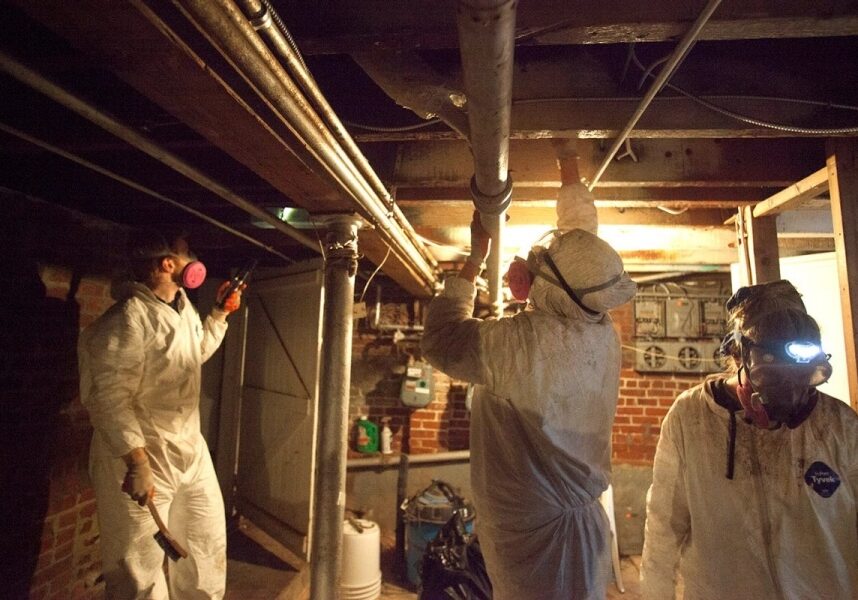Published in the January 2013 NJEA Reporter
Mold concernsMaintenance and custodial staff may be involved in cleaning up after damage from flood waters. More than likely, mold is the primary problem, but it is not the only hazard. Flood waters are likely to contain toxic chemicals and harmful bacteria, especially if flooding came from polluted rivers or bays, there are nearby industrial sites or underground industrial waste or storage sites, or sewage treatment plants in the area lost power or overflowed in the storm.
When staff can be involved: Large amounts of mold require professional remediation, involving enclosures and extensive personal protective equipment (PPE), much like an asbestos removal. If aggressive techniques must be used, such as pulling up damaged linoleum tile, the job should be treated like a large removal. However, staff may be involved in nonaggressive removal of small amounts of moldy material (less than 100 square feet).
If the heating, ventilating, and air conditioning (HVAC) system was submerged in flood waters, there may be a lot of dirt and debris as well as bacteria and mold. Schools should not run the HVAC system if staff know or suspect that it is contaminated, and staff should not clean it. Rather, the district must ensure that contaminated HVAC systems are professionally cleaned and repaired.
Health effects: Molds produce and release millions of spores small enough to be airborne. Most people are not affected by mold, but the spores of some molds can cause a wide range of respiratory effects, including allergies, asthma development and exacerbation, respiratory infections and bronchitis. Both asthma and bronchitis may have symptoms of shortness of breath, wheezing (sounds on exhalation) and coughing. People with asthma or sinusitis and those already allergic to mold are most at risk, but other people can develop allergies or asthma and suffer other effects. In addition, mold may cause eye and skin irritation.
Safe removal: The objective of safe mold removal is to prevent release of spores so workers and other building occupants don’t inhale them, and to avoid skin and eye contact with mold. Killing mold, as with bleach, is not enough, because even dead spores are allergenic. Nonporous materials, such as glass or metal, can be cleaned with a bleach solution.
The first step is to fix the cause of any water incursion, and dry wet areas using pumps, fans, blowers and/or dehumidifiers. Moldy porous materials can be removed using PPE (see box), and following these practices:
- The work area should be unoccupied, but people can be in adjacent areas, except those who are immune suppressed, have asthma, hypersensitivity pneumonitis, or allergies to mold or other substances.
- Re-wet, but do not soak, moldy materials with a mist of water to suppress spores and dust.
- Provide natural or local exhaust ventilation during all cleaning steps.
- Wrap and seal the items that will be discarded in plastic bags or a plastic sheet. They can be thrown out as regular trash.
- After an area has been cleaned and is dry, vacuum the floor and other surfaces with a high efficiency particulate air (HEPA) vacuum, and clean surfaces with a damp cloth or mop and a detergent solution.
Sewage Issues
Floodwater often contains infectious organisms, including intestinal bacteria, Hepatitis A virus, and agents of typhoid and tetanus. All of these except tetanus cause similar symptoms if ingested from contaminated food or water, including nausea, vomiting, diarrhea, abdominal cramps, muscle aches, and fever. Tetanus, however, can be acquired from contaminated soil or water entering broken areas of the skin, such as cuts, abrasions, or puncture wounds.
Tetanus causes severe muscle spasms, known as lockjaw. The symptoms may appear weeks after exposure and may begin as a headache, but later develop into difficulty swallowing or opening the jaw. Before working in flooded areas, be sure your tetanus shot is current (given within the last 5 years). Have flood-caused wounds evaluated for risk.
Harmful chemicals
If you know or suspect toxic or caustic chemicals are present, use chemical PPE (see box). Professional help may be needed for damaged asbestos-containing materials (pipe insulation and linoleum floor tiles) or lead (damaged lead paint).
Personal Protective Equipment
The Public Employees Occupational Safety and Health (PEOSH) program standard requires that school districts provide hazard-appropriate PPE, and provide fit-testing, worker training, PPE maintenance, and disposal of contaminated PPE. Local associations should talk with their UniServ field reps to ensure this happens, and check the contract for other health and safety language.
For removing less than 100 square feet of mold, not requiring aggressive treatment
- Non-vented goggles
- Long gloves that will protect you from skin contact with mold and cleaning chemicals. If only soap and water are used, household rubber gloves are fine. If biocides such as bleach or harsh chemicals are used, use chemical protective gloves made of natural rubber, neoprene, nitrile, polyurethane, or PVC.
- Respirators: either a half-face (nose and mouth mask) or full-face N-, R-, or P-95 respirator. N-95 half-face disposable respirators are available in hardware stores.
- Protective clothing, such as disposable coveralls, is desirable to prevent skin contact with mold and chemicals.
For sewage
- Wear at minimum long gloves and boots and at least an N-95 respirator in the work area.
- Disposable protective clothing is desirable, especially to protect broken skin.
For chemicals
- Wear special chemical protective outer clothing, chemical-resistant plastic or rubber gloves as described above and boots, and goggles.
Good hygiene for all floodwater hazards
- Do not keep food or beverages in the work area.
- Wash your hands and nails with soap and clean, running water, especially before work breaks, and meal breaks; at the end of the work shift, wash hands, hair, and scalp.
- After working, properly dispose of disposable work clothes, or put reusable items in plastic bags for laundering.
